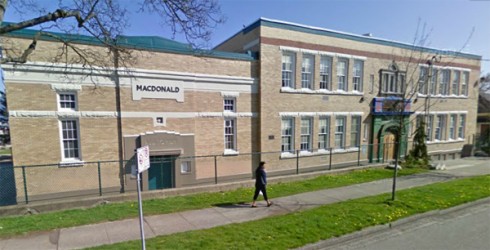Article Origin
Volume
Issue
Year
There is a new Aboriginal school for kindergarten to Grade 3 in the Downtown Eastside of Vancouver, and while people are calling it a mini-school it is a giant step to nurture Aboriginal youth by immersion in the teachings of a once-thriving culture on the West Coast.
Thirteen students enrolled at Macdonald Elementary School on East Hastings St. in September, and the new principal is ready to roll up the sleeves for the task-at-hand.
Enrolment stood at six after the Vancouver School Board approved opening last spring. Registration materials were distributed in the hope the school would open with a minimum of 12 students, which it surpassed.
“The focus has to be on parents, family and community, and what it is that they want for their children,” said Hutchingson, an educator from Haida Gwaii with a Haida and Tsimshian heritage and aspirations for the education system to be awakened to the needs of Aboriginal students.
Hutchingson got an education degree from Simon Fraser University in the early 1980s and taught elementary and secondary school in Prince Rupert. She rose to principal of a new school but knew success for Aboriginal students was not happening, “I thought, we have all the bells and whistles, the physical envelope was beautiful, but we still weren’t having the kind of success that I would like to see for Aboriginal students.”
Hutchingson took a job in the provincial Ministry of Education as Aboriginal Coordinator then Director of Aboriginal Education through the 1990s where she put an emphasis on analyzing and reporting Aboriginal graduation rates.
“What we know from research is that if you focus on an area, that area will grow,” she said. “The performance levels of Aboriginal students has grown and they are doing better, but it seems to have plateaued.”
The history of education in Aboriginal life is presently being written by the Truth and Reconciliation Commission (TRC). The TRC records the message from generations that attended residential schools in Canada from 1920s to 1970s. Few argue statistics on education in modern-day Aboriginal life are abysmal in a direct cause-and-effect aftermath of the failed Residential School system.
What else explains the reality that in the City of Vancouver, for example, only 32.1 per cent of Aboriginal youth will achieve their Dogwood Diploma, whereas the percent for non-Aboriginal students is 82.5?
It remains a system that is failing kids and the new principal is joined by others searching for ways to improve Aboriginal graduation rates in the province.
School District 57 in Prince George put together an Aboriginal Education Task Force in 2008 to report to the Aboriginal Education Board (formed in the mid-1990s). The priority was to increase academic achievement levels (that are at critical lows similar to Vancouver). The task force succeeded in stepping toward a solution when the ‘Aboriginal Choice School’— Nusdeh ‘Yoh House of the Future—began operations in Prince George in 2010, the first Aboriginal choice school within the public school system in the province.
- 3009 views

